With just a few days left before the final German broadcasters NDR, ARD and ProSiebenare were devoting most of their energy to the Eurovision Song Contest – as they had throughout May, with Germany acting as this year’s host.
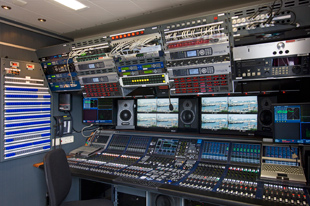
The first daily broadcast of the Total Eurovision special was broadcast on ProSieben, which also showed the first semi-final on 10 May. The second semi-final was broadcast by ARD on 12 May. The bulk of the broadcasts for both ARD and ProSieben were managed by outside broadcast units equipped with Lawo technology. As 'official supplier' and partner of German public broadcaster NDR, Stagetec provided all the mixing consoles.
Four 48-fader Stagetec Aurus consoles with a full complement of DSP were installed – three in mobile control rooms set-up on the Esprit Arena campus, and fourth in one of NDR’s HD outside broadcast trucks. Two of the four sound control rooms handled mixing of the broadcast sound – the first controled the music mix and passed its output to the second, which produced the international sound feed. The third and fourth sound control rooms acted purely as back-ups and were therefore equipped with identical hardware to allow seamless hand-over in the case of any failure of the main system.
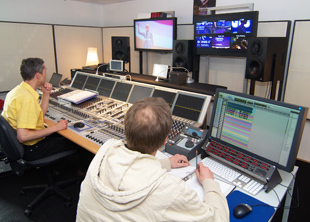
As is now normal for international events, the sound feed was produced in 5.1 and stereo simultaneously – this is why the back-up consoles feature the same abundant DSP capabilities as the main consoles.
The supporting infrastructure in Düsseldorf was provided by Park Studios using Media Mobil’s MMG Ü8 truck. As the OB trucks used are equipped with Lawo mc²66 consoles, Martin Mallach – the sound engineer responsible for the programme in the run-up to the final – did not have to adjust to new audio to accommodate the equipment change. Mallach is a committed mc²66 user, calling it ‘justifiably the standard when it comes to OB trucks’.
The 56-fader Lawo console in the MMG Ü8 is fully 5.1 capable. Two stage boxes with 40 mic inputs and 16 return paths plus two further stage boxes with 24 mic inputs and eight return paths can be connected via fibre optics.
With Hamburg being the second German Eurovision Song Contest ‘capital’, along with Düsseldorf, the official party was held in Hamburg’s Reeperbahn. This young, but already traditional event began with Eurovision Song Contest – Countdown für Deutschland covered by ARD. Following the broadcast of the final from Düsseldorf, a ‘Grand Prix’ party was held on the Reeperbahn at 12:15am, covered live by ARD. SWR’s FÜ2HD truck was used for broadcasts before and after the final round, as well as during the voting. This truck is also equipped with a Lawo mc²66 as its centre.
FÜ2HD’s Lawo console features a total of 140 microphone inputs, 192 DSP channels, and 56 faders. The router is equipped with a redundant router card and provides a maximum of 8,192 x 8,192 crosspoints. Matthias Eberhardt, technical director for FÜ2HD, is above all convinced by the usability of the Lawo console: ‘The controls on the mc²66 are just so intuitive. And our broadcasts also benefit from the console’s ability to create stereo and 5.1 surround sound simultaneously.’
Level control
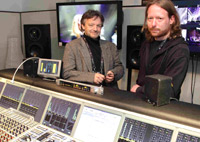
Ulli Fricke, sound engineer from NDR and Head of Sound at the Eurovision Song Contest explains: ‘We created separate but simultaneous mixes for stereo and 5.1 surround sound and we also had a full ‘hot’ backup system.’
Prior to the Eurovision Song Contest, Jünger Audio worked closely with NDR’s technical team to ensure that the T*AP units delivered exactly what the broadcaster needed. This meant some customisation was required: ‘We wanted the ability to easily and simultaneously control limiting and compression for stereo and 5.1 surround sound, says Fricke.
‘NDR has used Jünger Audio’s dynamics control units for many years and has always been happy with their audio processing performance,’ says Jünger Audio MD, Peter Poers. ‘On this occasion, NDR came to us with a special request – for surround dynamics processing in combination with sophisticated loudness control. This was something we had not tackled before but we were able to meet their request by making some small customisations.’
‘This event is something that I will probably only do once in my lifetime,’ says Fricke. ‘It was a logistical challenge because we had very little time between each act to change the whole stage situation, including mikes, stands, instruments and props. But everyone played their part and it was like lots of small gears working in one big machine. The end result was a huge success.’
Mic choices
Show hosts Stefan Raab, Anke Engelke and Judith Rakers used Sennheiser SKM5200-II handheld transmitters with Neumann KK104S capsules. The artists sang with the same microphone combination, or used an SK 5212-II bodypack transmitter with HSP4 headset microphone. Both options were used in combination with the EM3732-II two-channel receiver.
‘These transmitters and receivers provide a switching bandwidth of up to 184MHz, which gives sound engineers a high degree of flexibility in terms of frequencies,’ explains Sennheiser President, Ties-Christian Gerdes.
This year’s Eurovision Song Contest also saw the first appearance of the IE8 earphones with individually adjustable bass, which many of the artists uses as monitor earphones. All wireless Sennheiser systems were monitored and controlled remotely using the Wireless Systems Manager. (Full Sennheiser equipment list...)
Frequency management
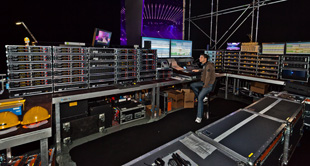
‘Throughout the production, a 20-strong team guaranteed the strict time scheduling, as a show like this requires a really high level of reliability,’ says Müller, MD of MM Communications. ‘In Düsseldorf, we had not only the stray pick-ups of the gigantic LED wall to contend with as a source of interference, but also the large DVBT transmitter stations in Cologne , and radio signals from a trade fair that was taking place close by at the same time. With our frequencies, we exploited all the gaps in the entire UHF spectrum between 470MHz and 790MHz in order to guarantee interference-free operation.
‘This time, the route from dressing room to the stage was extremely long. For this up-tempo show with its rapid song changes, the audio technology therefore had to be flexible and safe, and every member of the crew from MM Communications had to know exactly what to do.’
The individual monitor mix for each artist was worked out in rehearsals with the performers. The settings for all the acts were then saved on personal memory cards and read into the monitoring desk before each appearance, which also helped save time.
Eurovision intercoms
Also used to distribute video, audio and communications signals for the broadcasts was a comprehensive fibre-based Riedel MediorNet. Comprising MediorNet, RockNet, Artist and Performer components, the system helped turn the Esprit Arena – formerly a football stadium – into a 15,000-sq-m TV broadcast studio.
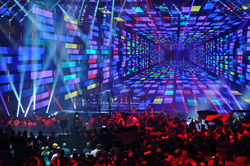 To provide the broadcast infrastructure and the signal distribution backbone the German real-time networks specialist installed a comprehensive system that distributed 70 HD/SD-SDI video signals, 1,200 audio signals and 734 communications ports. A total of 70 MediorNet mainframes were used to integrate the various positions and departments into a single system, including the TV compound, commentator positions and the press centre. MediorNet was responsible for transporting the broadcast signals to the OB trucks and distributing the video signals within the arena – for example to the monitors on various visitor floors, the video walls, as well as the Green Room and the commentator booths. ‘MediorNet’s network approach allowed us to keep full flexibility regarding the signal distribution and allowed us to monitor the complete installation,’ says Riedel ESC Project Director, Simon Korzen.
To provide the broadcast infrastructure and the signal distribution backbone the German real-time networks specialist installed a comprehensive system that distributed 70 HD/SD-SDI video signals, 1,200 audio signals and 734 communications ports. A total of 70 MediorNet mainframes were used to integrate the various positions and departments into a single system, including the TV compound, commentator positions and the press centre. MediorNet was responsible for transporting the broadcast signals to the OB trucks and distributing the video signals within the arena – for example to the monitors on various visitor floors, the video walls, as well as the Green Room and the commentator booths. ‘MediorNet’s network approach allowed us to keep full flexibility regarding the signal distribution and allowed us to monitor the complete installation,’ says Riedel ESC Project Director, Simon Korzen.
To guarantee a trouble-free event the entire system was set up with at least one layer of redundancy – only in cabling but also on a hardware level. Whether it was the redundant OB truck set-up, redundant MediorNet hubs or the possibility to broadcast via satellite or two 125 Mbit/s MLPS data links (also provided by Riedel), the redundant set-up secured the system against single points of failure.
‘It was one of EBU’s and NDR’s major demands to provide a flexible redundancy concept. With our MediorNet system we were not only able to provide a reliable system but we could also install everything very quickly and with a lot less effort than a solution over copper would have required,’ adds Korzen.
Around 1,200 audio signals were transported via MediorNet and RockNet during the event. To distribute the wireless microphone signals from the splitter world to the FOH, the monitor mix or the amp racks, an elaborated RockNet installation with connections to the MediorNet system was used.
The digital and analogue outputs from Sennheiser wireless receivers were used independently to feed an analogue and a digital RockNet module. In this way hardware redundancy was achieved at the earliest stage. RockNet expansion cards for digital Yamaha mixing consoles integrated the Yamaha PM5D consoles at the FOH and the monitor consoles into the audio network. The connections to amp racks in the ceiling and to the OB trucks in the TV compound were realised via MediorNet and RockNet links.
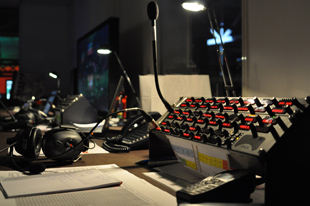
In addition to the commentator control panels, two TV screens were used in each booth. While one screen provided the programme, the second monitor offered parallel information on the voting and additional camera positions simultaneously. Due to MediorNet’s integrated Quadsplit-feature this could be done within MediorNet without the need for additional hardware.
All important positions at the event, from the director to the follow spot operators, were integrated into a comprehensive communications infrastructure including Riedel Artist digital matrix intercom, Riedel Performer digital partyline as well as digital and analog radio systems. The distribution of this infrastructure was taken care of by Riedel Artist and MediorNet, translating into significant savings of time and effort during setup and installation. A Riedel Juggler interface and various Riedel RiFace modules integrated the radio infrastructure directly into the wired communications system. This allowed every unit of the 500 mobile Tetra radios to easily communicate directly with dedicated intercom ports and vice versa.
Riedel’s responsibility was more than just distributing video, audio and communications signals. The signal distribution and the IT infrastructure within the press centre, located 200m away from the arena, was also provided by the German network specialist. A total of 1,000 workspaces with internet access, 400 laptops, 28 Wi-Fi access points and 60 printers were installed. Furthermore, Riedel managed the entire Internet connection of up to four Gbit/s for the facility. The press centre also featured an individual OB truck to broadcast press conferences. Integrated into the arena’s infrastructure over a redundant fiber link, it offered a seamless transfer of all signals between the two locations. This fibre link also enabled the distribution of all broadcast feeds to the press centre for feeding the installed monitors.
The signals from the broadcast centre reached more than 120m spectators in Europe, via more than 40 networks.
Details of the live sound set-up can be found here...
More: www.stagetec.com
More: www.lawo.de
More: www.junger-audio.com
More: www.sennheiser.com
More: www.riedel.net














